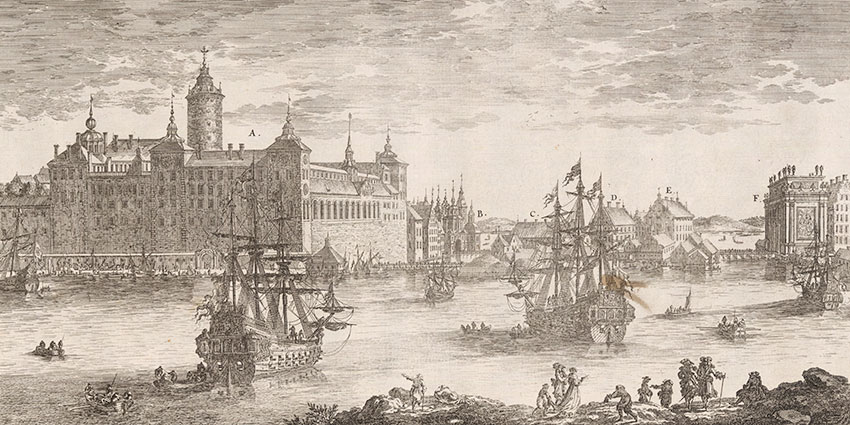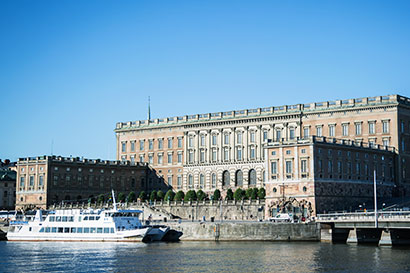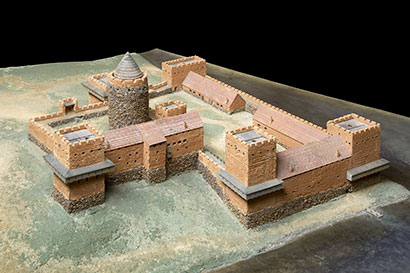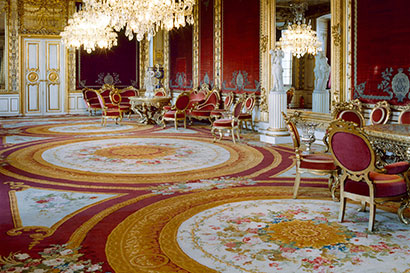
The Royal Palace of Stockholm: A history
When the palace was first built, in the 18th century, it created a stir in Europe, and today it is considered to be one of the emblematic buildings of the Baroque era. The older Tre Kronor Palace was consumed by flames in a fire that broke out in May 1697. The blaze started in the attic above the Hall of State, but what caused it was never clarified.
“The palace is beautiful, I could see that this time. It was built by the celebrated 17th-century architect Tessin and is not like any of the palaces in the other capital cities I have visited as a tourist. The room proportions in particular are beautiful, the architecturally artistic dimensions – length, width and height of the rooms. The large rooms and drawing rooms, thanks to their proportionality, don’t seem as colossal and high as in most palaces, where everything is always dull and official. The room dimensions give the Royal Palace of Stockholm a cosy, homelike feel.”
This was how foreign envoy to Sweden Alexandra Kollontaj described her first impressions of the Royal Palace of Stockholm in her diary in 1930. It attracted attention in Europe right from the outset, and the Palace in Stockholm is considered to be one of the emblematic European buildings of the Baroque era. Its history stretches back a long way. But how far exactly?
Protecting the heartland of the Kingdom of the Swedes
Some people believe that the Royal Palace in Stockholm is the oldest palace in Europe still in use as an official royal residence, but this naturally depends on how you view things. During prehistoric times, Lake Mälaren was a bay of the Baltic Sea with a number of channels out to the open sea. These channels became impassable due to uplift, and by the end of the Viking period only two remained – Norrström and Söderström. This meant that if you had control of the Lake Mälaren outlet you also had control of the Mälardalen Valley – the heartland of the Kingdom of the Swedes. It was therefore important to protect the inlet to Lake Mälaren, and it was moreover a strategic location for collecting customs duties from the shipping trade.
Finds from the 10th century
A castle was constructed at an early point on the site where the Royal Palace of Stockholm now stands. Archaeological excavations conducted on Helgeandsholmen in 1978-80 found traces of very old timber structures dating to the end of the 10th century. However, it is difficult to determine the function of these structures. Some people assert that the finds show that there was a castle structure on Helgeandsholmen as early as the late 10th century, while more cautious analysts maintain that there were only wooden barriers in the channel from Saltsjön into Lake Mälaren. These barriers may have been guarded, but the question is whether there was a garrison of soldiers or whether any such guard consisted of just one person. However, it is possible that there was already a simple barrier fort here in the 10th century, a wooden stronghold, that would then develop and be modified over the centuries.
Defensive installations develop
The oldest record of the castle’s existence is a letter from Birger Jarl and his son Valdemar, dated 1252. During the 14th century, the structure consisted of the stronghold – the actual castle with dwelling house – and the large outer fortifications to the north. The oldest section of this structure was the keep. In the 14th, 15th and early 16th century, the castle was besieged again and again. The best-known siege is perhaps that of the castle and city at the hands of Danish King Kristian II (Christian the Tyrant) in March 1520. It was not until the autumn that Kristina Gyllenstierna, widow of Sten Sture the Younger, finally surrendered the castle into Danish hands, whereupon noblemen, bishops and citizens loyal to Sture were condemned to death and executed in Stortorget – the Stockholm Bloodbath.
Strengthening defences
During the reign of King Gustav Vasa, the modern nation state of Sweden came into being and the castle in Stockholm became one of the King’s residences. The castle structure was initially enlarged for defensive purposes and was provided with additional fortifications. Among other things, ramparts were constructed to withstand artillery fire and so-called dry moats on the southern and western sides to hinder any assault. Several storeys were added to the keep and it was armed with cannons. For a long period the castle was the strongest defensive installation in the Baltic region. During the time of King Johan III, the castle was then transformed into a magnificent Renaissance palace with the aid of architect Willem Boy. This period saw the property furnished with a new royal apartment, a new royal chapel and a new hall of state. The catholic queen was given her own chapel, a racquet court was constructed and a new bath house was built and the old one equipped with a copper “swimming bath”.
Modern residence befitting a Great Power
During the reign of King Gustav II Adolf, central government offices and courts of appeal were set up, and housed within the walls of the palace. By that time the palace had lost its defence function, and sweeping conversion and construction plans were being drawn up. The Great Power that was Sweden would finally have a representative and modern royal residence. However, due to the severely-strained state of the kingdom’s finances it took a long time before anything drastic could be done. It was not until 1690 that Nicodemus Tessin the Younger was commissioned to modernise at least the northern portion of the palace. Royal apartments were now planned and a complete reconstruction of the royal chapel, located in the north-eastern section. Tessin had studied architecture and landscape gardening for many years on the continent, in France, Italy and England. Through the agency of Queen Kristina, he was taken on as a pupil of Lorenzo Bernini and he was heavily influenced by the austere Baroque architecture in Rome. On his return to Sweden and Stockholm, he knew exactly what a modern palace should look like.
Palace in flames
Work on the interior was well under way when the fateful fire broke out at two in the afternoon on 7 May 1697. Detailed records of what happened and other evidence enable the course of events to be summarised quite closely. For example, we know that Queen Dowager Hedvig Eleonora’s ladies-in-waiting had just finished their meal when thick smoke billowed forth outside the windows, and when they were opened it could be seen that the palace was on fire. The Danish King’s envoy, Bolle Luxdorph, witnessed the whole thing and described how the Queen Dowager could barely stand, shocked and bewildered – “highly altered” – and had to be carried down the stairs.
Tower cannons tumble
The fire spread rapidly and soon even the keep was alight, as evidenced by the deafening boom when the tower’s cannons crashed down into the Queen Dowager’s wine cellar. It was never determined what caused the blaze. We know that the fire began in the attic above the Hall of State and we know that those whose task it was to watch this attic were not at their posts on this fateful afternoon. The chief fire officer had sent one of these guards out on an errand and another guard had left his post without permission.Everyone managed to get out of the palace, but the material damage was extensive. The fire destroyed first and foremost the older section of the palace, but the newly-built north wing was also damaged. Quantities of priceless documents, books and manuscripts went up in smoke when the national archives and library were ravaged by the fire.
Rapid rebuilding required
Just the day after the fire the regency decided that the palace should be rebuilt, and the task fell to Nicodemus Tessin the Younger. Only six weeks after the huge fire Tessin had drawings of the new palace ready to show the Queen Dowager. At the same time the architect had been commissioned by the Danish King to design the Royal Palace in Copenhagen, which perturbed King Karl XII, who was anxious that the palace in Stockholm should:
“Not in any respect be eclipsed in magnificence by the Danish palace."
According to Tessin’s plans, the new palace would be built in six years, but it was to take almost sixty due to lack of money. For many years, construction of the palace was at a complete standstill, and when it got going again work did not progress very fast. Nicodemus Tessin the Younger died in 1728 and responsibility for construction of the palace was taken over by his son Carl Gustaf Tessin. However, he delegated supervision of the work to architect Carl Hårleman.
In December 1754, King Adolf Fredrik and Queen Lovisa Ulrika were finally able to move into what is now known as the Bernadotte Apartments. Up to this point the Wrangelska Palace on Riddarholmen had been the Royal Family’s official residence. Despite the long period of construction they kept to the designs from 1697, at least with regard to the exterior. The interiors were largely
The altar and the throne
The palace façades facing the city remain largely unchanged to this day and each one has its own character. The north façade, austere and plain with its double ramps up to the northern portal, dominates the city skyline. The south façade exudes splendour, designed as a Roman triumphal arch with texts of tribute to King Karl XII. From here you enter the South Gate, which extends the full height of the building. From here you can also access the two most important ceremonial rooms in the palace and the symbols of secular and divine power: The Hall of State and the Royal Chapel. The altar and the throne were the pillars between which a moral Swedish society would develop. The western side is the King’s side, with warlike attributes and medallions of Swedish kings from Gustav Vasa to Karl XI, while the eastern, more graceful and informal side, facing towards Saltsjön and Logården, was the Queen’s.
The Royal Palace was not built solely as a residence for the Swedish monarch and his family; it was also intended for the whole of the central Swedish state administration. Accordingly, offices were provided here for Sweden’s government and for the various ministries. The Royal Library was also housed within the palace walls.
A vibrant palace
During the 19th and 20th century, government offices, the government, the Riksdag (Swedish parliament) and the Royal Library were to move out of the palace, and in 1981 King Carl XVI Gustaf and Queen Silvia also chose to leave their home here in order to take up residence at Drottningholm Palace instead. However, the Royal Palace of Stockholm remains a living palace.
It is King Carl Gustaf’s official residence and is used for official entertaining by the Head of State. The King and Queen also have their offices here, and the Office of the Marshal of the Realm and the Office of the Marshal of the Court are also based here.

The palace was built in Baroque style by architect Nicodemus Tessin the Younger and was designed in the form of a Roman palace. Photo: Raphael Stecksén

The changing of the guard and military parade is a popular public attraction in the Outer Courtyard. Photo: Raphael Stecksén

Model of the predecessor to the Tre Kronor Palace, as it is believed to have looked in 1280. Photo: Alexis Daflos

Kristian II (1481-1559), also known as Christian the Tyrant, was King of Denmark, Norway and Sweden. He took over the castle in Stockholm in the siege of 1520. Photo: Nationalmuseum

Model of (predecessor to) the Tre Kronor Palace, as it is believed to have looked in the 14th century. Viewed here from the south east, diagonally from above. Photo: Alexis Daflos

The Tre Kronor Renaissance Palace 1663. In the foreground, the main entrance to the palace can be seen, with the Hall of State building to the right of the archway and the Royal Apartment to the left. Model by Lars Agger. Photo: Alexis Daflos

Model of the Tre Kronor Palace as it would have looked just prior to the fire in 1697. From the north. Photo: Alexis Daflos

Copperplate engraving of the Tre Kronor Palace, from the great palace fire of 7 May 1697. Photo: The Royal Court

The Vita Havet Assembly Rooms are located in the eastern section of the palace. Today the King and Queen use these rooms for welcoming guests prior to official dinners. Photo: Alexis Daflos

The Victoria Salon was furnished during the reign of King Karl XV. The wallpaper on the inner wall is red velvet with Queen Lovisa Ulrika’s monogram in gold and silver. Photo: Alexis Daflos

Karl XI’s Gallery is Baroque in style and is modelled on the Hall of Mirrors at Versailles. It features an impressive ceiling painting showing King Karl XI’s war in Skåne in the 1670s. Photo: Alexis Daflos

King Carl XVI Gustaf was painted by artist Nelson Shanks. The temporary backdrop for the portrait was constructed in the Antechamber to the Bernadotte Library. The picture was taken on 17 May 1991. Photo: Alexis Daflos

Photograph taken in connection with H.M. Queen Silvia’s 70th birthday. Photo: Julia Hetta









